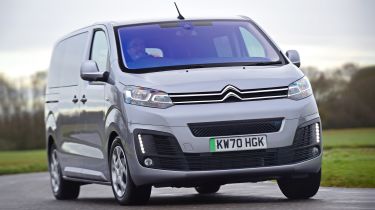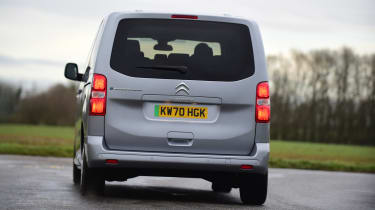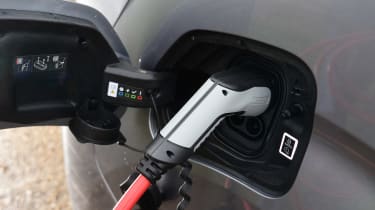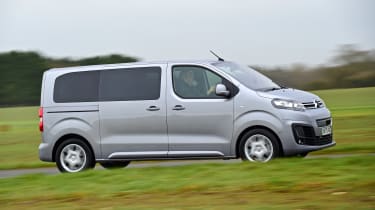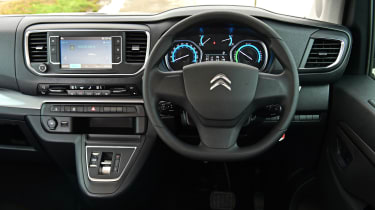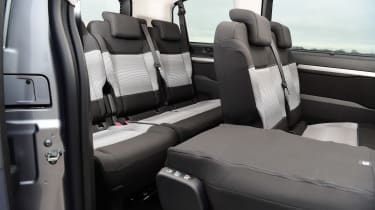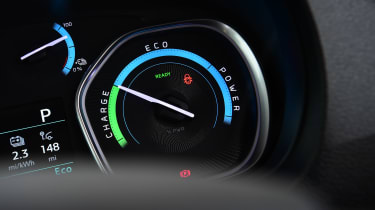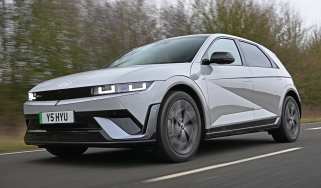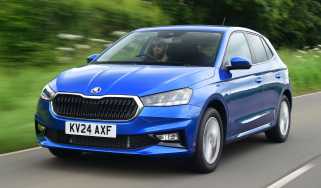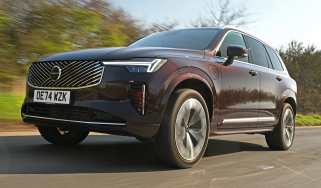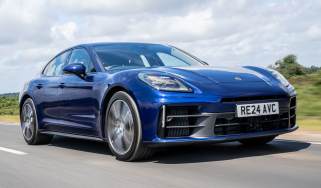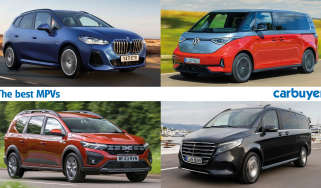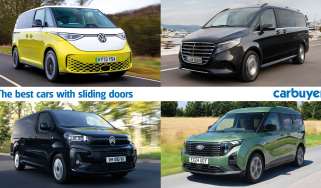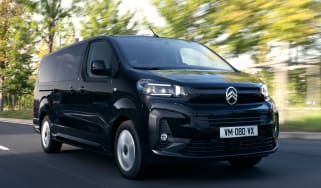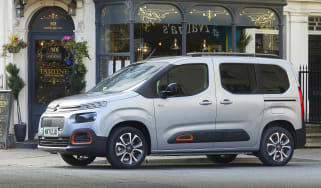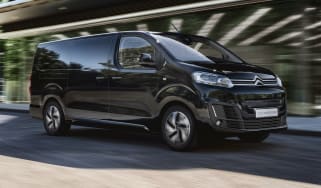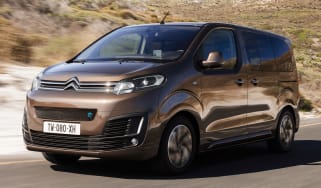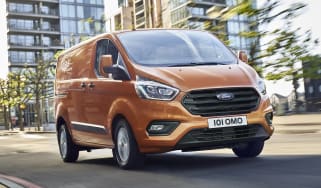Citroën e-SpaceTourer MPV review
"The Citroen e-SpaceTourer offers versatility, efficient electric power and a touch of style, but struggles to shrug off its delivery-van origins"
Pros
- Electric version offers decent range
- Smooth
- Huge interior space
Cons
- Obviously van-derived
- Rather noisy in the back
- Limited boot space with all seats up
Sometimes, when more than five people need to travel together, even a big MPV doesn’t quite do the job. Now, the Citroen e-SpaceTourer seeks to satisfy the needs of the larger travelling group, competing with the Mercedes V-Class and Volkswagen Multivan in the luxury minibus market. It’s perhaps more aimed at private hire firms and shuttle services than private buyers, but large families may also find a lot to like.
 Top 10 best eight-seater cars 2025
Top 10 best eight-seater cars 2025
In common with those two rivals, the Citroen finds its basis in a commercial vehicle, in this case the latest Citroen Dispatch van, which in turn shares some parts with the Peugeot 3008 and Citroen Grand C4 SpaceTourer MPVs. Changes to the bumpers and headlights distinguish the SpaceTourer from its hard-working sister models and, when fitted with alloy wheels, the big Citroen actually looks quite fetching.
While the idea of your ‘luxury’ transport being essentially a van with windows isn’t the most appealing thought, some reassurance can be derived from the fact that vans like those are designed to work hard and prove reliable, while being cost-effective to operate. Plus, as the chassis of the Dispatch has a lot in common with that of the Citroen C4 SpaceTourer, the SpaceTourer is impressively car-like to drive for a van-based model.
In January 2022, Citroen discontinued the diesel engines from the SpaceTourer lineup, leaving just the electric e-SpaceTourer model. It did the same with the Citroen Berlingo, and the van versions of each model. Citroen isn’t alone in this; Vauxhall and Peugeot have also stopped selling diesel engines in its mechanically identical van-based models, too. You can still buy a diesel-engined Toyota Proace Verso, though, and Citroen will still offer diesel SpaceTourers for some people, such as wheelchair-accessible conversions.
Before then, the engine range included three diesel options. The BlueHDi diesels have 118bhp, 142bhp or 175bhp and return around 40mpg, while the electric e-Spacetourer is powered by a 134bhp motor connected to a 50kWh battery for a driving range of up to 136 miles. Don’t expect to cover that many miles between charges in winter or on long motorway journeys, however.
The e-SpaceTourer can be chosen in two lengths. The M is a shade less than five metres and the lengthy XL stretches a full 5.3 metres – this version allowing up to nine passengers to stretch out in comfort. Family buyers are best served by the flagship Flair trim, while the more basic Business Edition trim is aimed at private-hire drivers. But Citroen’s revised pricing means that many buyers are likely to plump with the base model, which qualifies for the plug-in car grant and is over £15,000 less expensive than the Flair.
The Citroen SpaceTourer is a practical MPV that's quiet and good to drive but heavy seats mean some owners will need a helping hand and a garage if they want to change its seating layout. The e-SpaceTourer has many advantages but its relatively small battery pack means it’s not suited to long distances.
Range, charging & running costs
With vans like the Dispatch having to work for a living, Citroen is keen that its commercial vehicles should be as efficient as possible. This trickles down handily to the SpaceTourer, which returns up to 39.8mpg in the BlueHDi 145 and 180.
Find a used example with the BlueHDi 120 engine, and fuel consumption reduces to 44.1mpg. Used diesel versions are subject to the standard VED rate (road tax) annually, the exception being the e-SpaceTourer's zero emissions and £0 tax bill - even if it costs more than £40,000.
With a 50kWh battery, the e-SpaceTourer can manage up to 136 miles from a full charge. Firms using the e-SpaceTourer in cities where there's lots of congestion should find it can perform a few shuttle runs before needing a top-up, and it can be fast charged at up to 100kW at a public charger. Citroen has partnered with PodPoint to offer buyers an 11kW or 7.4kW home wallbox, charging the battery in less than 3.5 hours or five hours respectively.
In reality, though, you may find it very hard to get close to Citroen’s estimates. We recently tested the e-SpaceTourer’s efficiency on a cold day, and it was achieving less than two miles per kilowatt-hour. That equates to a range of around 85 miles, so you’ll need to be prepared for more frequent charges when the temperature drops – and ideally find chargers with shelters or amenities.
It’s also worth noting that that figure was achieved with just one person on board; load up the car with people and the e-SpaceTourer will be even less efficient.
The e-SpaceTourer isn't cheap but it does come with some big advantages, including much lower Benefit-in-Kind (BiK) liability than the diesels and free access to low-emissions zones like central London, along with some other perks for EVs such as cheaper maintenance.
SpaceTourer insurance groups range from 12 to 18 between the diesel models, and routine servicing can be performed by any official Citroen workshop. The car is also covered by the same three-year warranty as all other new Citroens in the UK.
Electric motor, drive & performance
Thanks to a chassis closely related to those of hatchback Citroens, the e-SpaceTourer really doesn’t feel as awkward and bulky to drive as you might expect. The M version feels manageably sized and you can thread it confidently down twisting country roads without fear of where its extremities are.
The raised driving position is helpful, providing a commanding view of the road ahead and making it easier to place the car in corners. It also has an impressively tight turning circle and is a lot easier to park than you might think. The steering is light, too, although this leads to it feeling somewhat vague on the open road.
The e-SpaceTourer copes well with bumpy, broken roads. Citroen claims that the Dispatch van’s suspension has been comprehensively retuned for passenger duties and our experience seems to confirm that.
Every engine for the conventionally powered SpaceTourer is a diesel, the least powerful being a BlueHDi 120 that's only available with a six-speed manual gearbox, while the BlueHDi 145 and 180 get an automatic as standard.
The BlueHDi 120 with the six-speed manual gearbox takes 12 seconds to get from 0-62mph, and has a top speed of 99mph. The gearshift is accurate and easy, although it doesn’t feel as good as that of the Volkswagen Caravelle.
With 134bhp and instant torque, the e-SpaceTourer feels punchy around town. The fact it's relatively narrow also means it feels no more unwieldy to drive than an SUV, and it's pleasantly quiet apart from the odd clunk from the suspension. A driving mode called ‘B’ increases the amount of energy harvested while decelerating but it's not quite strong enough for one-pedal driving.
The electric powertrain makes the car much smoother to travel in, because there are no vibrations or unwelcome noise to contend with. As a result, it’s more relaxing to drive than the diesels.
Interior & comfort
Citroen maintains that it has added sound-deadening to the SpaceTourer’s interior to lessen the van-with-windows effect somewhat, but diesel versions are still somewhat noisy to travel in – a shame given how smooth the ride is. It does feel at least one step up from a typical delivery van, though, with a nicely finished dashboard.
A seven-inch widescreen display controls the DAB radio, Bluetooth and Apple CarPlay systems, with a navigation system optional. All models have cruise control and a USB port, as well as more practical features including parking sensors, LED daytime running lights and ISOFIX child-seat mountings. Hill-start assistance makes rural progress easier, too.
The passenger compartment is treated to a central overhead console, incorporating outlets for the air-conditioning system, as well as ambient lighting similar to what you might get on a private jet, while sunblinds, seatback trays and power sockets are also provided.
The doors and boot can be opened using the Hands-Free Access facility, while the rear windscreen can be opened independently of the rest of the tailgate in situations where space is limited, such as an enclosed parking space. The sliding side doors can be motorised, too.
The SpaceTourer Rip Curl was a special limited-run model that was offered alongside similarly badged versions of the Berlingo, C3 Aircross and C4 Cactus. It was the most distinctive version of Citroen’s largest MPV, with subtle styling changes like black door mirrors and rubbing strips helping to set it apart from the regular models. Special 17-inch wheels were also fitted along with tinted rear windows, along with a smattering of the surfwear brand's emblems dotted around the bodywork to finish things off. Inside, the dashboard was engraved with a laser-etched design and there's a 3.5-inch colour display in the centre of the instrument cluster. A seven-inch touchscreen, colour head-up display and keyless entry were also standard.
Practicality & boot space
While not being the most imaginatively designed interior environment, the passenger compartment of the medium-length SpaceTourer does at least offer plenty of space – even the tallest passengers can expect plenty of legroom, while there’s plenty of head and shoulder room, too.
As is often the case with vehicles like this, there’s a compromise to be made between passenger and luggage space. With all three rows of seats in situ, there’s a pretty minimal area left for loads. However, if the third row is folded down, the SpaceTourer gets closer to resembling a van again, with a total of 2,381 litres of luggage capacity, rising to a massive 2,932 litres in the XL version.
It's worth noting that truly transforming the SpaceTourer requires removing the rear seats, and they're rather heavy. Some will find it easier to do this with two people, and you'll also need somewhere to store the seats when they aren't in use. The large rear tailgate can also be a bit awkward to open and close in confined spaces, or for anyone who isn't very tall.
Reliability & safety
Van origins mean you can expect the SpaceTourer to be robust and easy to repair. Our annual Driver Power owner satisfaction survey has never covered the Citroen Dispatch before, but we’d like to think the SpaceTourer will make a showing as its popularity grows.
The SpaceTourer has yet to feature in our Driver Power owner satisfaction survey, but the Citroen brand itself came a very disappointing 28th out of 29 marques scrutinised in our 2021 results, a 10-place fall from the year before. Considering that Citroen expects the SpaceTourer to become popular with private-hire companies and upmarket hotels, reliability should be high on the agenda, but 22.9% of Citroen owners who participated in our survey reported at least one fault in the first year of ownership.
There are no such worries over the safety of the SpaceTourer: it has already been awarded a full five-star rating after independent crash-testing by Euro NCAP. This takes into account the impressive list of crash-preventing measures the Citroen features – including autonomous emergency braking that activates if it senses an oncoming hazard.
Lane-departure warning, blind-spot monitoring, road-sign recognition and driver drowsiness monitor are other features designed to improve safety on long journeys – as is the active cruise control.

